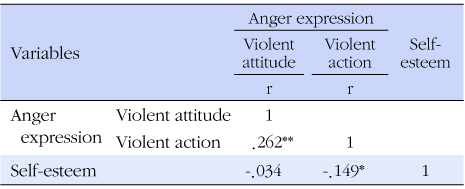References
1. Chae YK. Verification on the model of expression modes and moderating effect of adolescents's anger 2001. Gwangju: Chonnam National University; Unpublished doctoral dissertation.
2. Cho HG. Stress disease and hypochondria about oriental medicine 1991. Paju: Open books;
3. Choi JE. A study on the variables influencing the attitude and behavior toward adolescent violence 1998. Seoul: Ewha Womans University; Unpublished master's thesis.
4. Compas BE. Stress and life events during childhood and adolescence. Clin Psychol Rev 1987. 7(3)275–302.
5. Feindler EL. Adolescent anger control 1989. New York: Plenum Press;
6. Gottlieb MM. The angry self: A comprehensive approach to anger management 1999. Phoenxi, AZ: Zeig, Tucker, & Co. Press;
7. Han DH. The influence of the anxiety, depression, self-esteem on the anger expression type in adolescents 2009. Seoul: Seoul Women's University; Unpublished master's thesis.
8. Howells K, Day A. Readiness for anger management: Clinical and theoretical issues. Clin Psychol Rev 2003. 23319–337.
9. Jang IS. Effect of assertiveness training on assertiveness behavior, problem solving ability and changes in interpersonal relationship of nursing students 2002. Daegu: Keimyung University; Unpublished master's thesis.
10. Jeon IJ. The relation of self-control and self-esteem on the adolescent's anger level and anger expression mode 2002. Seoul: Sogang University; Unpublished master's thesis.
11. Jeon SC. The influence of high school students' anxiety and depression on self-esteem-focused on the general high school students in the 3rd grade- 2006. Gyeonsan: Yeungnam University; Unpublished master's thesis.
12. Kim JA. Influences of parental attachment of children's perception on anger experience and anger expressions of children 2007. Seoul: Yonsei University; Unpublished master's thesis.
13. Kim JH. The effects and its management plans of per ceived family functions on self-esteem and job searching behaviors. -focusing on junior college students- 2009. Seoul: Sangmyung University; Unpublished master's thesis.
14. Kim JH, Kim SA. Attitude toward violence in Korea. Korean Criminol Rev 1991. 1991(1)211–219.
15. Kim TY. The relationship between juvenile sports activity participation and violence behavior 2000. Seoul: Ewha Womans University; Unpublished master's thesis.
16. Kisac I. Anger provoking reasons on high school anduniversity students. Procedia Soc Behav Sci 2009. 12202–2206.
17. Kwag OG, Sung KW. Effect of lecture on oral presentation on anger expression, assertive behavior, and self-esteem in nursing students. J Korean Acad Community Health Nurs 2009. 20(3)351–360.
18. Kwon HJ. A qualitative study on the expression and relief of anger by female adolescents. Chung-Ang J Med 1992. 17(3)287–299.
19. Martinez YAS, Schneiderer BH, Gonzales YS, de Toro MPS. Modalities of anger expression and the psychosocial adjustment of early adolescents in eastern Cuba. Int J Behav Dev 2008. 32(3)207–217.
20. Moon SH, Park YJ. Relation of self-reported attachment style, trait anger and anger expression in adolescent women. Korean J Women Health Nurs 2008. 14(2)143–149.
21. Park SA. Effect of college student's perceived parentadolescent communication style and patenting attitude on anger expression 2010. Busan: Dong-A University; Unpublished master's thesis.
22. Prager KJ. Intimacy status and couple conflict resolution. J Clin Psychol 1991. 48(4)272–276.
23. Reasoner RW. Building self esteem: Parent's guide and teacher's guide 1982. Palo Alto, CA: Consulting Psychologists Press;
24. Suh KH, Yang SA. The role of narcissism and self-esteem in psychological stresses and subjective well-being. Korean J Health Psychol 2010. 15(4)653–671.
25. Seo SG. Differences in anger thought, belief, expression depending on narcissism and self-esteem level. Korean J Couns Psychother 2007. 19(3)719–734.
26. Sigfusdottir ID, Silver E. Emotional reactions to stress among adolescent boys and girls. Youth Soc 2009. 40(4)571–590.
27. Sin MS. Effects of parent's-rearing attitudes on a communication and a self-esteem of their children-focus on adolescents(middle school students) 2010. Yangpyeong: Asia United Theological University; Unpublished master's thesis.
28. Tafarodi RW, Swann WB. Two-dimensional self-esteem: Theory and measurement. J Pers Individ Dif 2001. 31653–673.
29. Yang JY. Effect of attachment style, self-esteem, silencing the self on relationship satisfaction 2005. Seoul: Ewha Womans University; Unpublished master's thesis.



